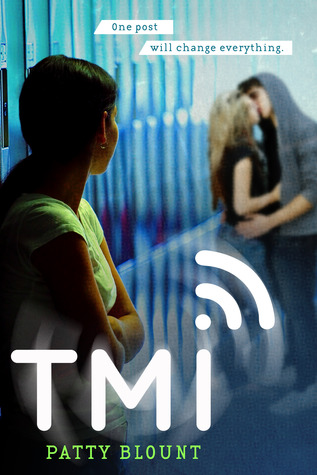Release Date: August 6, 2013
Publisher: Sourcebooks Fire; 336 pages
Best friends don’t lie.
Best friends don’t ditch you for a guy.
Best friends don’t post your deepest, darkest secrets online.
Bailey’s falling head-over-high-heels for Ryder West, a mysterious gamer she met online. A guy she’s never met in person. Her best friend, Meg, doesn’t trust smooth-talking Ryder. He’s just a picture-less profile.
When Bailey starts blowing Meg off to spend more virtual quality time with her new crush, Meg decides it’s time to prove Ryder’s a phony.
But one stupid little secret posted online turns into a friendship-destroying feud to answer the question:
Who is Ryder West?
Today is my stop on the two part TMI tour with Sourcebooks Fire! I'm featuring a guest post with the author, Patty Blount, on her writing style! Thanks so much to Sourcebooks for inviting me to be a part of this tour.
I’m a huge fan of The X-Files. Way back in season 1, there was a line of dialogue from the episode called Ghost in the Machine in which the brainiac CEO of a computer corporation says this to Agent Scully:
It's a puzzle, Miss Scully, and scruffy minds like me like puzzles. We enjoy walking down unpredictable avenues of thought, turning new corners…
“Scruffy minds” makes me think about the Plotters vs. Pantsers debate, an issue that divides authors more than any other.
Plotters write using various organization techniques like Post-It Notes, story boards, binders, index cards, and so on. Pantsers just wing it. Is either approach wrong? No. Yet, Plotters feel freakish that they can’t write by the seat of their pants and devout Pantsers I know try every new plotting technique that comes out. I don’t know why this is true, only that it is. I suspect it’s because writers are never convinced they can truly write.
I am a Plotter. I know this because I used to write by the seat of my pants and never finished a single book until I finally decided to approach the project the way I do my day job tasks -- with deadlines and small chunks of work I can track each day. It’s clear to me that I am not a ‘scruffy mind’. I need order and structure and goals in order to write. Before I discovered this about myself, I used to just wing it. And the result was an unfinished novel I just kept writing for years. It became something of a Winchester House – it just went on and on with no end in sight. Scenes that served no purpose, weeks with two or three Wednesdays, characters who weren’t even on-stage one moment suddenly Poofing into a scene, antagonists who just hatched evil because I’d decided they must be evil.
Before I start a new project, I devote days – sometimes weeks – to organizing my thoughts, to de-scruffing my mind. It’s not enough for me to know a character likes video games while another likes art. I have to know why. Who encouraged those interests? Does anybody resent these characters because of those hobbies? These decisions drive the What Happens question that propels a story from start to end.
Let’s try an exercise together. Suppose we’re writing a novel with the same premise. The premise is simply this: “a man must find a lost object.”
Who is our man? He could be the owner of the object. Maybe the object is the last tangible connection he has to a dead relative. How does he feel about this relative? Does he want to escape his connection? Or embrace it? If the object is valuable, the man could be desperate. Or generous. Or turn corrupt. If the object is knowledge, the man could have a closed mind or an open one. The possibilities stagger me.
Learning who the man in our story is doesn’t just provide shape to the story, it defines it. Man finds object could be Harry Potter and the Deathly Hallows, The DaVinci Code, The Maltese Falcon, or Indiana Jones. The previous paragraph could yield a dozen different stories by deciding who the man is and a dozen more by deciding what the object is.
My mind can’t write a word until all these questions are settled or I end up writing in circles, undoing the words I wrote yesterday and the day before, until my writing is nothing more than a hamster on a wheel. I am one of those writers who tries whatever plotting method is popular. I’ve used Snowflake. Index cards. Story boards. Post-it notes. Plain old outlines.
They all work. And you know what? I suspect dedicated Pantsers do this, too. They just do so subconsciously so that their writing instinctively knows just where to go to make order out of chaos -- to solve the puzzle.










No comments:
Post a Comment